The recent drought conditions across
some of areas in the US have caused a
number of wildfires in western states.
The media has focused on the fact that
some states are cancelling the 4th of
July fireworks in fear that they could
ignite dry brush and trigger yet another
wildfire.
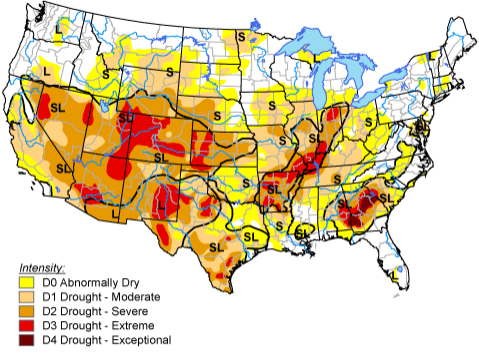 |
|
Source: University of
Nebraska |
But there is another effect the
drought is having on many parts
of the country - damage to the
nation's crops.
Reuters: - Just one year ago
Jeff Scates saw the worst
flooding on his southern
Illinois farmland since 1937.
Today, Scates is watching his
corn fields shrivel from the driest
season in 24 years.
"We've gone from one extreme to
the other, from being flooded on
three-quarters of the farm now
to a drought," said Scates, 42,
who with his family members
farms 15,000 acres of corn,
soybeans and other crops along
the Kentucky-Indiana border
where the Ohio and Wabash Rivers
meet.
Scates said his corn is still in
better shape than many fields of
his neighbors, who farm sandier
soils that do not retain
moisture. Moisture is needed to
develop a strong root system to
sustain plants in the hottest
months of July and August.
The percentage of crops in good
conditions has declined far below
the 5-year range for this time of
the year.
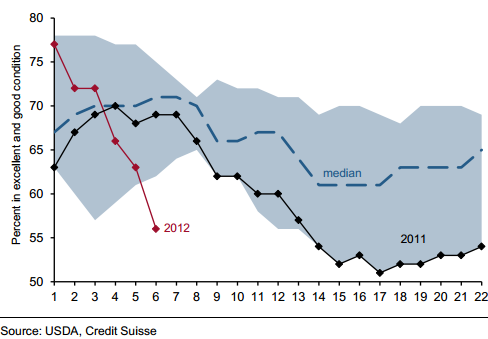 |
|
Corn crops % in good
conditions (source: Credit
Suisse) |
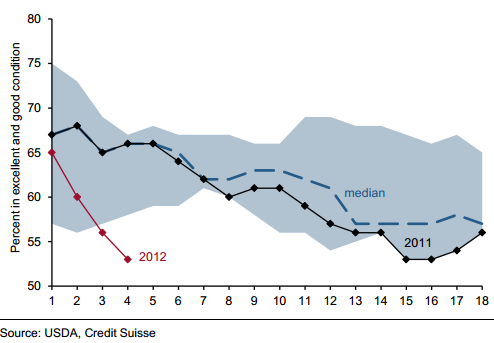 |
|
Soy crops % in good
conditions (source: Credit
Suisse) |
Futures: - The most recent
crop progress report released on
June 25 is not up to date with
the effects of the
weather of the past few
days. But even so, the downgrade
to the crop’s health was steep.
The good-to-excellent portion of
the crop fell to 56% from 63%
the week before. Last year at
this time, the good-to-excellent
section was 68%. The July 2
progress report will almost
certainly contain a further
reduction in the estimate for
the quality of the crop.
What's particularly troubling is
that these drought conditions
are not limited to the US.
FT: - Fears of crop damage
in Russia due to dry weather
supported wheat prices, with US
benchmark prices hitting an
eight-month high on Friday,
shrugging off concerns about the
eurozone and global economic
growth.
Concerns over the past few weeks
about limited rainfall in
southern Russia elevated this
week as farmers in the region
faced the critical flowering
stage. Winter wheat goes through
the flowering phase in the last
one to two weeks of May into
early June.
And Ukraine's wheat output is
materially lower as well. It is
particularly painful for a nation
that
desperately
needs hard currency.
 |
|
Ukraine's wheat output (1000
MT, source: USDA) |
In places such as North Korea, where
food shortages are a fact of daily
life, the drought may have a severe
impact on the population. This is
clearly a dangerous development
given the nation's history of
military
threats in times of extreme
conditions.
The Telegraph: - North
Korean soldiers have been
dispatched to water crops that
are withering in the worst
drought to affect the country in
more than a century, with
the United Nations warning that
yields for staples
such as wheat, barley and
potatoes will inevitably be
affected.
Even Australia is cutting wheat
output projections.
Reuters: - Australia slashed
its winter wheat production
forecast by more than 7 percent,
heightening global supply
worries and boosting U.S.
futures, a day after projections
of harsh weather hitting output
in top exporters Russia, Europe
and the United States.
This confluence of global damage to
harvests is driving up prices for
agricultural
commodities, with corn
experiencing the sharpest increase.
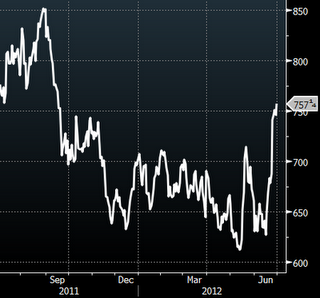 |
| Wheat
futures |
 |
| Soy
futures |
 |
| Corn
futures |
A major geopolitical concern
stemming from these trends is food
inflation. As discussed before, the
Arab Spring had less to do with zeal
for freedom/democracy and
more
to do with rising food prices.
Nations whose currencies have
weakened recently (Egypt, Iran,
Pakistan, etc.) will be particularly
vulnerable.
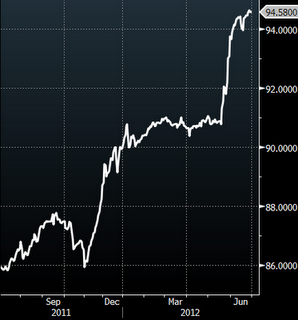 |
|
Pakistani Rupee at
historical lows (number of
rupees per dollar) |
The Telegraph: - Food price
inflation is already a headache
for policymakers around the
globe, faced with the pressures
of growing populations, rising
urbanisation and changing diets.
That means the latest surge in
crop prices state-side, with the
US producing more than 40pc of
global corn exports, is causing
some concern. The dry weather is
also affecting the Black Sea
producers, as well as those on
the North China Plain.